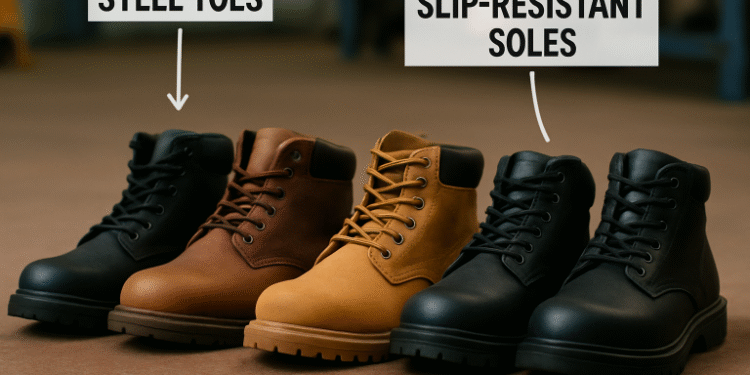Protecting workers starts from the ground up—literally. Even minor oversights in gear selection can have significant consequences in high-risk environments. Ensuring employee safety is beneficial and essential to a company’s long-term success, reputation, and productivity. Protective footwear is a frequently underestimated element of workplace safety, the first defense against various occupational hazards. Building and enforcing a robust footwear policy through resources like a company work boot program can prevent injuries, boost morale, and foster a culture centered on well-being.
The significance of thoughtfully designed footwear protocols continues to rise, especially with diversified work environments and evolving safety standards. Proper shoe selection and maintenance are essential in mitigating risks, whether the workplace is a construction site, warehouse, or factory floor. By aligning footwear policies with industry guidelines and leveraging specialized programs, companies can minimize liability, improve job satisfaction, and set a standard for proactive safety management.
Importance of Footwear in the Workplace
Proper workplace footwear guards employees against dangers such as impacts, sharp objects, chemical spills, and extreme weather conditions. Failing to require adequate footwear can invite unnecessary hazards, resulting in preventable injuries and lost productivity. Good footwear also supports comfort, reducing fatigue during long shifts and enabling workers to perform their tasks efficiently and safely over extended periods.
For many sectors, introducing comprehensive footwear standards not only meets compliance obligations but leads to tangible reductions in onsite injuries. Businesses that leverage a formalized boot or shoe policy can notice dramatic improvements in workforce satisfaction and engagement, as employees recognize their employer’s commitment to their health.
Common Footwear-Related Injuries
- Slips and Falls: Shoes lacking grip or made of the wrong material can cause workers to slip on wet, oily, or uneven surfaces, resulting in falls that may lead to sprains, fractures, or even head trauma.
- Musculoskeletal Disorders: Extended wear of ill-fitting or unsupportive footwear may trigger pain or chronic issues not only in the feet but also in the legs, knees, hips, and lower back.
- Skin Conditions: Prolonged use of improperly fitted shoes can result in blisters, corns, and even fungal infections without appropriate breathability or moisture control.
These injuries are among the most common non-fatal workplace incidents and are often the result of under-prioritized or outdated footwear policies.
Developing Effective Footwear Policies
Employers can strengthen safety outcomes through systematic policy design. Successful company footwear policies generally encompass three main pillars:
- Hazard Assessment: Each worksite should be thoroughly evaluated to classify hazards tied to specific operations, floor types, and exposure risks unique to the job.
- Footwear Standards: Companies must clearly outline approved footwear—steel-toe boots, slip-resistant soles, insulated or waterproof designs—ensuring they address external dangers and individual ergonomic needs.
- Provision and Maintenance: A sustainable policy provides clear guidelines for how footwear is chosen, supplied, replaced, and cared for. Employers may supply approved shoes directly, offer a voucher system, or reimburse purchases when they meet set criteria.
Innovations in Safety Footwear
Material science and wearable technology advances continue to drive the evolution of safety footwear. Modern boots often feature lightweight, yet ultra-durable materials, ergonomic insoles, and puncture-resistant outsoles. Some companies are introducing technological enhancements such as embedded sensors that monitor pressure points, fatigue, or environmental hazards, even sending alerts when unsafe conditions are detected. These innovations transform footwear from passive protection into active contributors to workplace safety, offering enhanced comfort and critical data to reduce risk. Learn more about these innovations.
Legal and Regulatory Considerations
Employers have a statutory duty to keep their working environment safe, which includes providing suitable footwear wherever risks are present. Regulations like those from the Occupational Safety and Health Administration (OSHA) in the United States demand adherence to industry-specific standards, particularly where heavy machinery, chemicals, or slippery surfaces are concerned. Failure to enforce these requirements may lead to legal penalties and jeopardize employee well-being. Keeping up with regulatory changes and updating footwear policies is critical for ongoing compliance and risk management.
Training and Employee Awareness
Written policies are only as effective as their adoption. Employee orientation and recurrent training must highlight the rationale for each rule, describe the risks of neglect, and walk employees through proper shoe selection and footwear care. Practical sessions can demonstrate inspection techniques, offer fitting advice, and explain why specific shoes are task-specific.
- Understanding accident statistics and the link to improper footwear
- Identifying proper footwear for various duties
- Establishing cleaning and replacement routines to maximize protection
Monitoring and Enforcement
Consistent enforcement is key to ensuring workplace footwear policies achieve long-term safety goals. Businesses can implement scheduled and surprise spot checks to monitor compliance directly on job sites, while maintaining digital logs for transparency and accountability. Leveraging digital tools like wearable tech or app-based checklists helps streamline compliance tracking and simplifies recordkeeping. Employee feedback mechanisms like anonymous reporting or regular safety meetings enable managers to identify patterns, address gaps, and continuously refine footwear protocols. When noncompliance is detected, immediate corrective actions, such as refresher training or equipment reassessment, can minimize risks. In more serious or repeated instances, linking policy adherence to performance evaluations or issuing formal disciplinary measures reinforces the importance of protective footwear. These combined efforts foster a culture of safety and compliance, minimizing injury risk and supporting OSHA-aligned practices. Prioritizing ongoing footwear policy enforcement protects workers and enhances operational efficiency and brand credibility in safety-conscious industries.
Conclusion
Strong company footwear policies form the backbone of a proactive workplace safety strategy, especially in industries where physical hazards are routine. These guidelines do more than reduce injury risks—they demonstrate a company’s commitment to employee well-being and accountability. When employees see their employer investing in their protection through structured policies, morale and job satisfaction naturally improve. Furthermore, enforcing proper footwear standards helps organizations comply with OSHA regulations and avoid costly fines or legal issues. A well-crafted policy should include precise footwear requirements, allowance or reimbursement programs, and regular safety training to reinforce expectations. Companies can also explore new technologies in protective footwear—such as slip-resistant soles or smart wearables—to improve safety outcomes further. Building strong footwear protocols ultimately boosts productivity, minimizes downtime from injuries, and strengthens a culture where safety is prioritized and respected across all levels of the organization. This fosters long-term resilience and a strong brand reputation.









